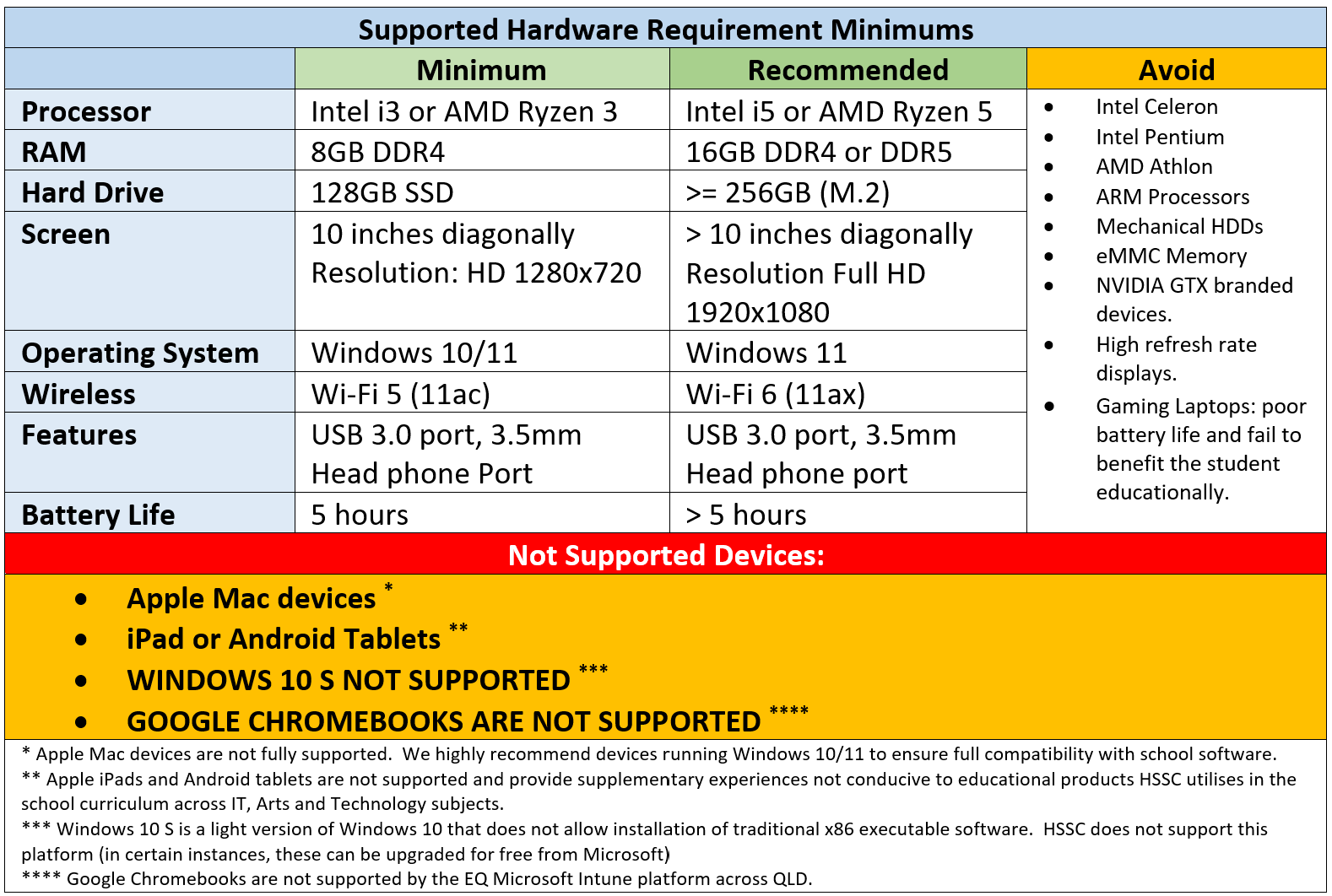HIGHFIELDS STATE SECONDARY COLLEGE
BYOD PORTAL

Technical Specifications

|
|
Central Processing Unit/Processor/CPUIntelThe Gen indicator specifies how new the CPU is. Current generation CPUs are denoted with the number 7. the 1100, 11th generation range of CPUs are more energy efficient with minor performance bumps over previous generations.
AMDAMD offer new powerful CPUs that in general perform faster than Intel offerings. The RYZEN based processors in the 4000 series, such as 4700, 4500 and 4300 are excellent value for money. The equivilency is 4700=i7, 4500=i5, 4300=i3. AMD older CPUs are less powerful than Intel CPUs, by comparison, a A8 is equivilent to a Intel i3 and a A10 is near equivilent to a Intel i5. Please see the 'Hardware Considerations' page for further information regarding which is the best CPU |
|
Hard DrivesThere are varying technologies when it comes to hard drives. SSDThis is the fastest consumer level hard drive available. It is recommended for best performance and experience. Capacity sizes will generally be smaller than conventional mechanical HDDs, but the net performance benefit is >10x better. HDDThis is a traditional mechanical HDD, they have the greatest storage capacity, but also are prone to being easily broken as they have physical moving spindles and platters. Mechanical HDDs are notoriously slow and not recommended unless large capacity is important SATA/M.2 and NVMeThis is technical terminology explaining the serial interface that connects a hard drive to a computer. NVMe (M.2) is the fastest consumer standard, with SATA being the older technology. SATA and M.2 support SSDs. eMMCThis is a flash storage standard that should be avoided. It is commonly found on very cheap devices because of its terrbly slow performance. Please see the 'Hardware Considerations' page for further information regarding the benefits of SSDs over mechanical HDDs |
|
Wireless ConnectivityHSSC supports all wireless standards, but currently operates on a 11ac network. We recommend 11ac, which is backward compatable with 11n. We recommend that the device is DUAL BAND and supports 5GHz frequency. 802.11xThis is a networking implentation standard that allows computers to connect to wireless network points. This does not connect to mobile towers, but to physically cabled devices that network the school. This wireless network is then interconnected to the internet. 11ac is the more powerful standard which allows for high data transfer speeds, but is more susceptible to interference (5GHz band). Dual BandDual Band is terminology to describe the frequency in which devices communicate wirelessly. The two bands are 2.4GHz and 5Ghz. The benefits of 5GHz is less clutter on the spectrum, whereas 2.4GHz is susceptible to interefence due to different technologies also using that band. BluetoothThis is a Personal Area Network device that allows students to connect peripheral devices such as wireless mice so that a USB dongle is not required. Bluetooth is not a requirement for devices at HSSC. 3G/4G/LTEThese are telecommunication standards for data transmissions using Mobile networks. HSSC does not support the use of these devices, and they are prohibitted from being used to bypass the schools internal network filters. |
|
Intel GraphicsIntel provide onboard graphics processing units (GPUs) which are built into the CPU. The purpose of these devices is to display the images to the screen, they are additionally used to accelerate games, media and applications for their visual effects. Intel GPUs are not terribly powerful, however, they serve their value as a free GPU and are capable of performing all the tasks of which students will need at HSSC. Please note: While they are capable of running all required software, they will not provide the highest performance experience possible. Discrete GraphicsDiscrete graphics or dedicated graphics, are additional hardware pieces added to supplement the default Intel Graphics that comes with the system. The discrete units provide higher performance for gaming, media and applications. Please see the 'Hardware Considerations' page for further information regarding the benefits of Dedicated Graphics |
|
DDR MemoryThe system memory of a computer is used to store 'temporary' assets and resources for applications and Windows. The more memory a computer has, the less reliant it is on using the HDD to store temporary files while using an application. This is a benefit because HDDs are historically slow (SSDs improve this significantly), thus the RAM/Memory of a computer is designed to be extremely fast. Adding additional memory is a benefit when using large scale software such as AutoDesk and Adobe products. If you have a student who will undertake Media or Graphics, it is recommended they have 8GBs. The minimum for HSSC is 4GB of memory, we strongly recommend 8GB. |
